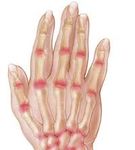RHEUMATOID Clinical Case: ARTHRITIS - Simple Tasks
←
→
Page content transcription
If your browser does not render page correctly, please read the page content below
Rheumatoid Arthritis
Case Study
Keith is a 59 year-old White male with a history of COPD and congestive heart
failure requiring two hospitalizations in three years. Keith presented to your office
complaining of increased fatigue, pain, stiffness in the joints in his hands and
swelling in his left foot and ankle for a week. He states his lower extremity swelling
“feels different” than his normal edema and he has been experiencing increased
stiffness in his hands and ankles for a few months. The stiffness is more pronounced
in the mornings. Keith denies any shortness of breath or chest pain, but his wife
states he has been experiencing a decreased appetite and pain in both hands for two
months. He reports taking all of his medication on schedule, including Digoxin which
he recently began taking, and denies using his inhaler in more than a month.
Keith at a Glance
• 20 years old • 400 mg of Digoxin Vitals upon exam:
• Height: 6’1’’ • Albuterol inhaler as »» Temp: 98.9°F
• Weight: 264 lbs needed »» HR: 84 bpm
• History of congestive »» BP: 140/90
heart failure and COPD »» Resp: 21
Is It Rheumatoid Arthritis?
Upon an initial musculoskeletal exam the joints in Keith’s
hands are swollen and display moderate decreased range of RA IS CHARACTERIZED BY
motion. Keith’s left foot and ankle are swollen and tender INFLAMMATION OF THE SYNOVIUM,
and exhibit a severe decrease in range of motion. Keith’s
presentation is complicated by his history of CHF with
OFTEN LEADING TO BONES EROSION
edema, but the pain in his hands and feet raises your concern AND JOINT DEFORMITY.
for a new diagnosis of arthritis.
The most common form of autoimmune arthritis, THE UNDERLYING CAUSE OF THE
rheumatoid arthritis (RA) affects at least 1.3 million AUTOIMMUNE DISEASE IS NOT KNOWN.
Americans and about 75 percent are women.1 In fact,
between one and three percent of women will develop RA during their lifetime, and although RA may occur at any age,
it usually begins after age 40.1,2 RA is characterized by inflammation of the synovium, often leading to bone erosion and
joint deformity. The underlying cause of the autoimmune disease is NOT known.
In addition to pain and swelling, RA may cause stiffness and limited range of motion in
affected joints. Inflammation may also affect organs, such as lungs or eyes. Other signs
and symptoms of RA include: fatigue, low-grade fevers, loss of appetite, and firm lumps,
called rheumatoid nodules, which grow beneath the skin in places such as the elbow
and hands.
RA related joint pain, swelling or decreased range of motion can impede normal self-
care, recreational and social activities. Complications related to RA can be severe and
life-threatening. RA increases the risk of: coronary artery disease, stroke, cardiovascular
disease in general, inflammation including pericarditis, and scarring and inflammation
of lung tissue.2
Rheumatoid arthritis affects many Keith’s edema and fatigue may be attributable to his CHF and his loss of appetite
parts of the body. This image
may be related to his recent use of Digoxin, but these symptoms in combination
shows the impact on the wrist
with his pain and swelling make you even more concerned.
and the small joints of the hand.RA MAY OCCUR AT ANY AGE, THOUGH IT
USUALLY BEGINS AFTER AGE 40
Making a Rheumatoid Arthritis Diagnosis
Early symptoms of RA may mimic several other diseases Radiographs may help rule out trauma or other pathology
and progress slowly, making it difficult to diagnose. Early and also may be used to track the progression of RA over
signs and symptoms of RA, in addition to those listed time.2
above, may include: 1, 3
• Tender, warm, swollen joints Once diagnosed, treatment should begin immediately.
• Stiffness in joints lasting for hours, which is There is no cure for RA, but current treatments offer
especially worse in the morning most patients relief of symptoms and allow for close-to-
»» Osteoarthritis most often does not cause normal or normal functioning. Some patients may even
prolonged morning stiffness achieve “remission” from the right medications, where
• Dry eyes and mouth from a related health problem, no symptoms of active disease are present. The overall
Sjogren’s syndrome goal of treatment is to lessen symptoms, prevent joint
• Muscle soreness damage, and maintain or improve functionality. No single
treatment works for all patients and many people with
When symptoms begin, they typically affect smaller RA will change their treatment plan at least once in their
joints, such as the metacarpophalangeal joints (MCPs) lifetime.1
and metatarsophalangeal joints (MTPs).2 As the disease
progresses, joints affected may include ankles, wrists,
knees, elbows or hips.2 Pain and swelling may flare
and fade or event remit. Over time, RA can cause joint
deformities.
Diagnosing RA depends on physical findings, medical
history and the exclusion of other diagnoses. There is
no single blood test to diagnose RA but some may help
confirm the diagnosis. Some tests for RA include:1
• Anemia (a low red blood cell count)
• Rheumatoid factor (an antibody found in as few
as 30 percent of patients at the onset of RA but as
much as 80 percent of patients with RA for some
time)
• Antibodies to cyclic citrullinated peptides, or anti-
CCP for short (found in 60–70% of patients with RA)
• Elevated erythrocyte sedimentation rate and/or This 54 year-old man with seropositive rheumatoid arthritis
C-reactive protein (blood tests which can suggest developed multiple subcutaneous nodules after several months
systemic inflammation) of methotrexate therapy.
RA By The Numbers
• More than 1 million Americans suffer from RA1
• About 75 percent of those affected with RA are women1
• One to three percent of women will develop RA in their lifetime2
• RA typically involves more than one joint; if one knee or hand has
RA, the other one usually does too3
Early detection and treatment of RA, within the first
This echo T2 image of a patient’s 12 weeks of symptom onset, is critical to help your
neck demonstrates the pannus
around the odontoid patients avoid long-term complicationsReferring to a Rheumatologist RA Referral Checklist
Keith’s case is anything but definitive: his prior medical ϽϽ Complete blood count
history may explain all of his symptoms, but his wife’s ϽϽ C Reactive Protein (CRP) blood test
insistence he has had prior episodes of pain in his hands ϽϽ Anti-cyclic citrullined peptide (CCP) blood test
concerns you. ϽϽ Comprehensive Metabolic Panel
ϽϽ Digoxin level
After sharing your suspicion with Keith and his wife, you ϽϽ Rheumatoid factor
explain you would like to order some additional tests ϽϽ Erythrocyte sedimentation rate
and refer him to a rheumatologist to help confirm, or ϽϽ Document of pain and swelling onset
rule out, a diagnosis of RA. You counsel him on the risks »» Note timing and medications taken
associated with RA, particularly for someone with heart ϽϽ Most recent echocardiogram
and respiratory diseases. Keith’s wife asks why you think ϽϽ Document timing of labs
it could be RA since she thought only women got the »» With a note of medications taken at time of
disease. You explain RA is indeed more common among labs
women, but men do get the disease as well, and although
there is no single test to confirm RA, Keith’s symptoms Reminders
warrant further exploration.
• Discuss complications associated with RA,
You counsel Keith to try to remain as active as he can, particularly related to heart and lung disease
symptoms permitting. You explain patients with RA • While waiting for patient to see a rheumatologist,
often get some relief with low-impact exercise, such as acute treatment is possible with NSAIDs to reduce
swimming, walking and cycling. Benefits from low-impact pain
exercise can be evident in four-six weeks, but you stress to • Continue taking medications as prescribed
Keith he needs to listen to his body and reduce his activity
should he experience any dyspnea or lightheadedness.
When you are referring your patient to, or consulting
with, a rheumatologist for the suspicion or treatment of
RA, there are critical steps you can take to provide the
best possible patient care, while avoiding the duplication
of tests and procedures.
Your role is essential to the long-term health of your patients and maintaining their quality of life.
- RHEUMATOID ARTHRITIS -
Citations
1. American College of Rheumatology (ACR). (2013). Rheumatoid Arthritis. [Fact 2. Mayo Clinic. (2013). Rheumatoid Arthritis. [Fact sheet]. Retrieved from http://
sheet]. Retrieved from http://www.rheumatology.org/practice/clinical/patients/ www.mayoclinic.org/diseases-conditions/rheumatoidarthritis/ basics/definition/
diseases_and_conditions/ra.asp con20014868
3. Centers for Disease Control and Prevention (CDC). (2013). [Fact sheet].
Retrieved from http://www.cdc.gov/arthritis/basics/rheumatoid.htm
SimpleTasks.orgYou can also read

























































